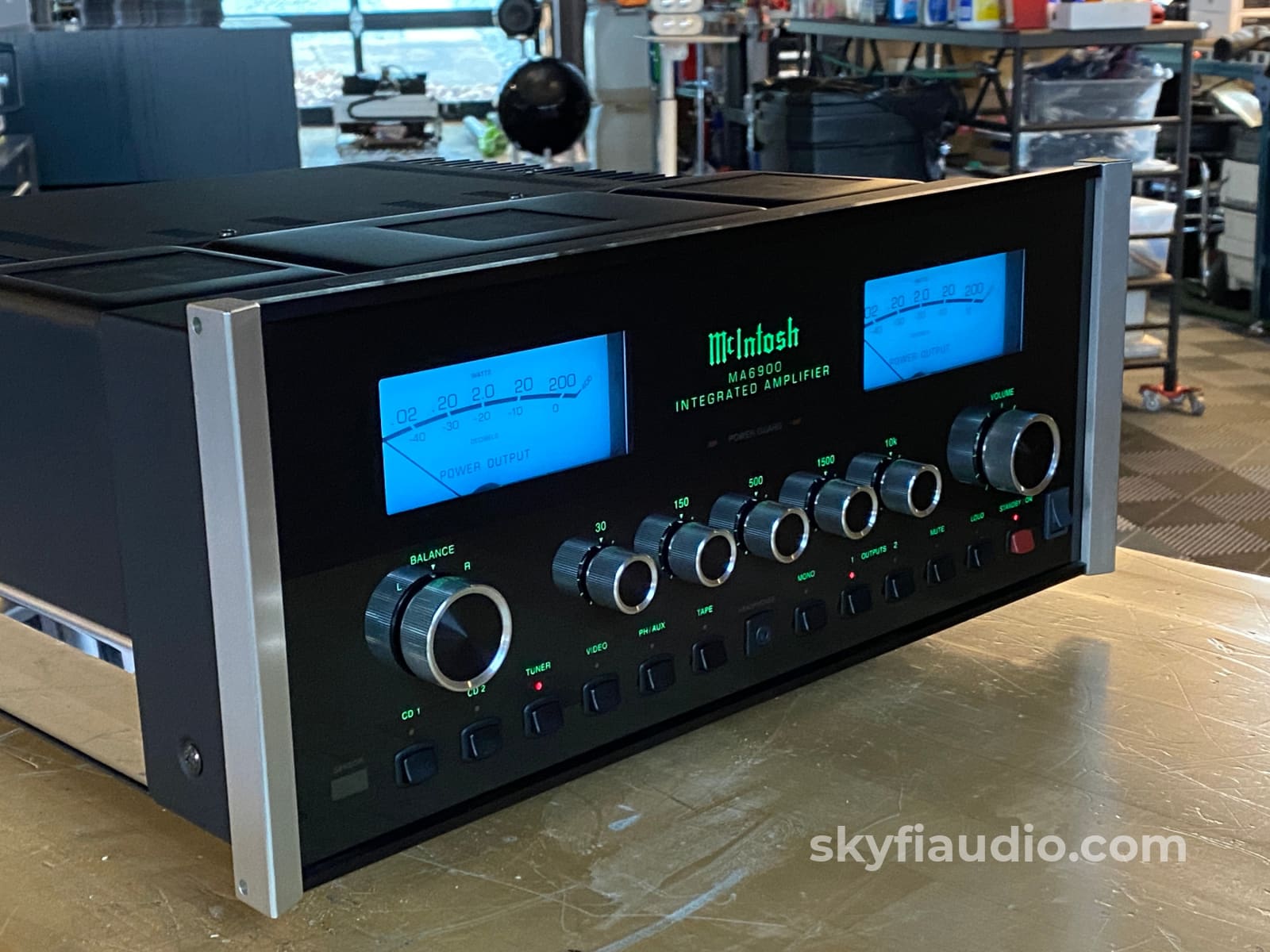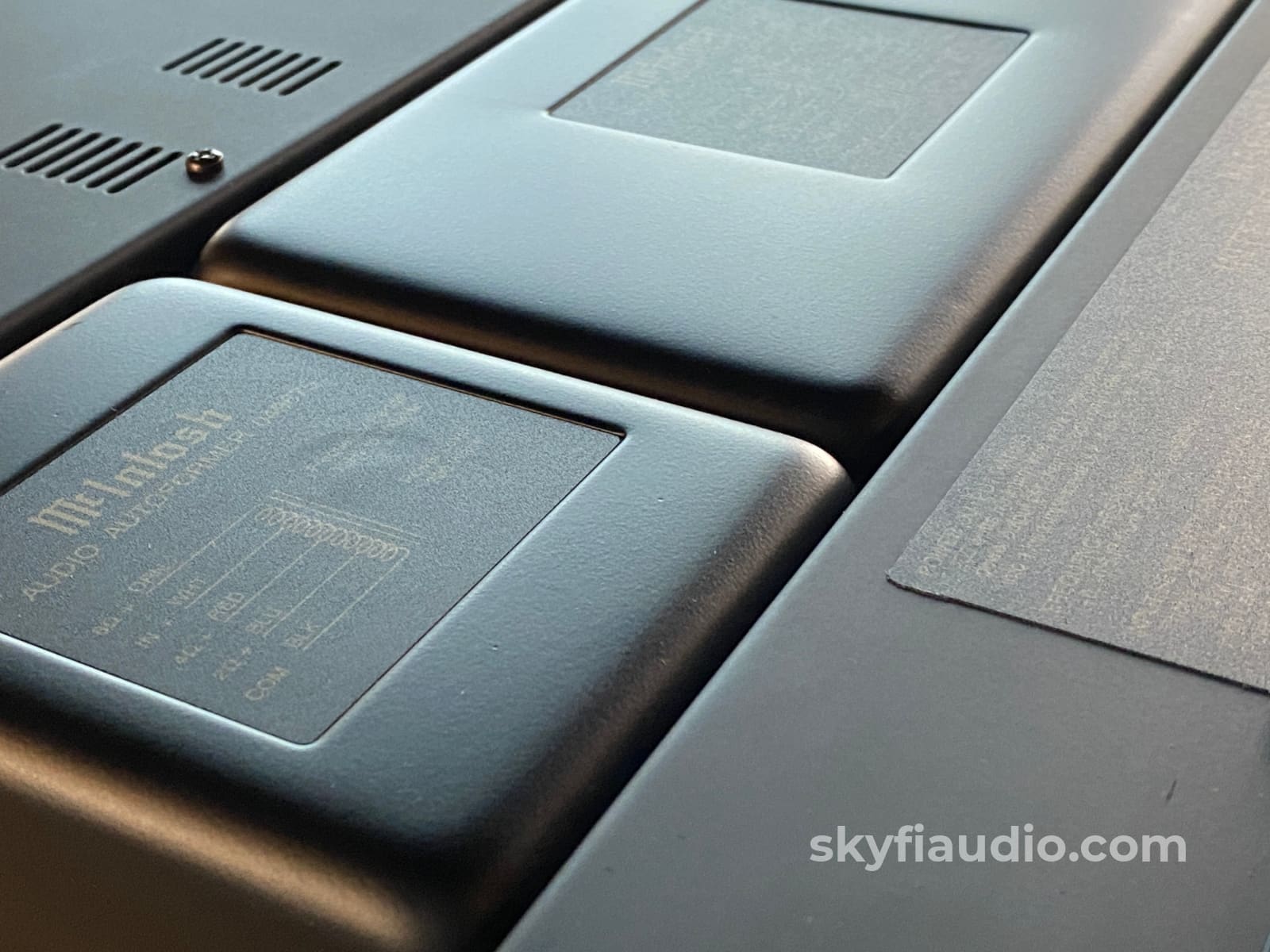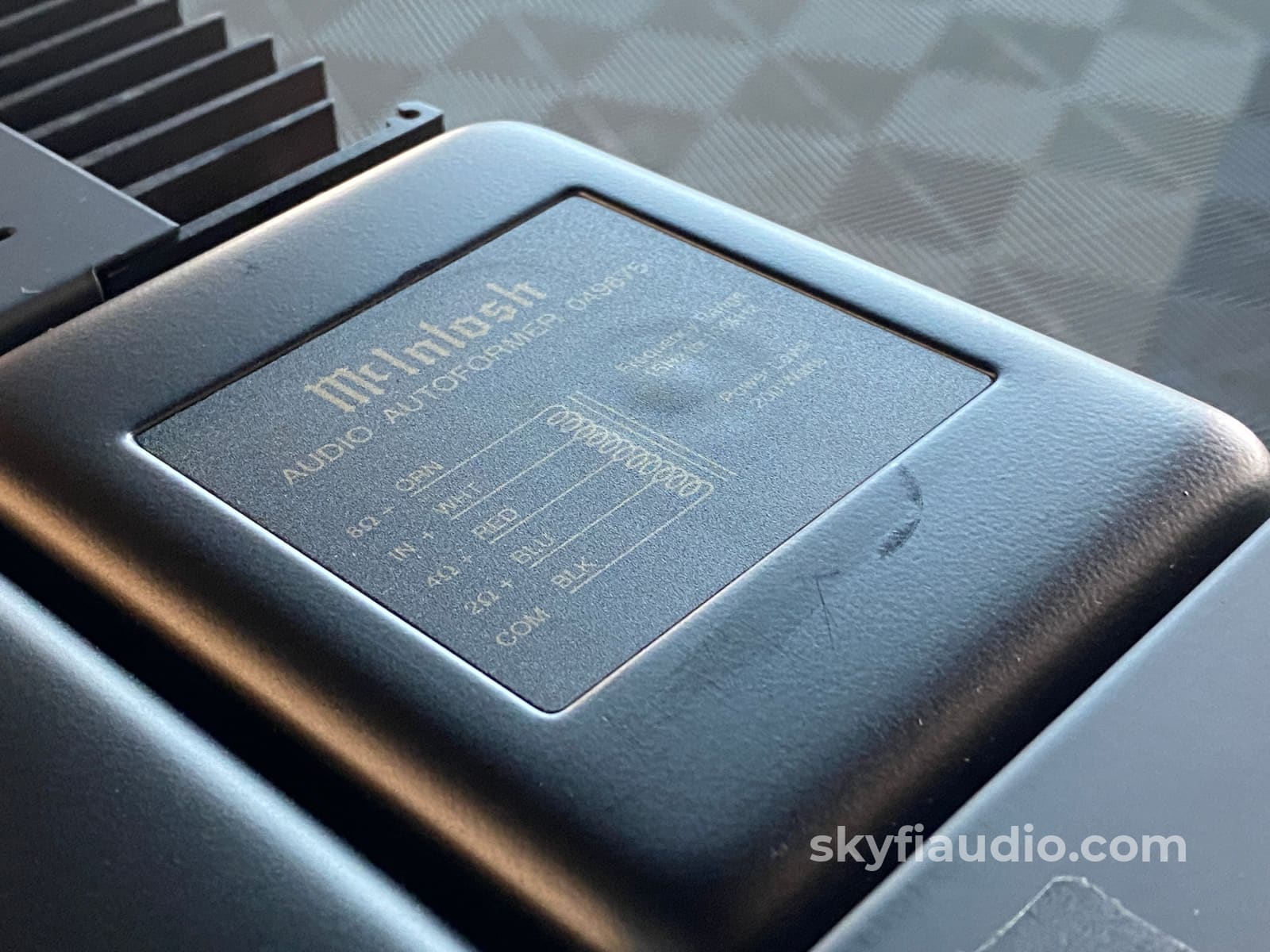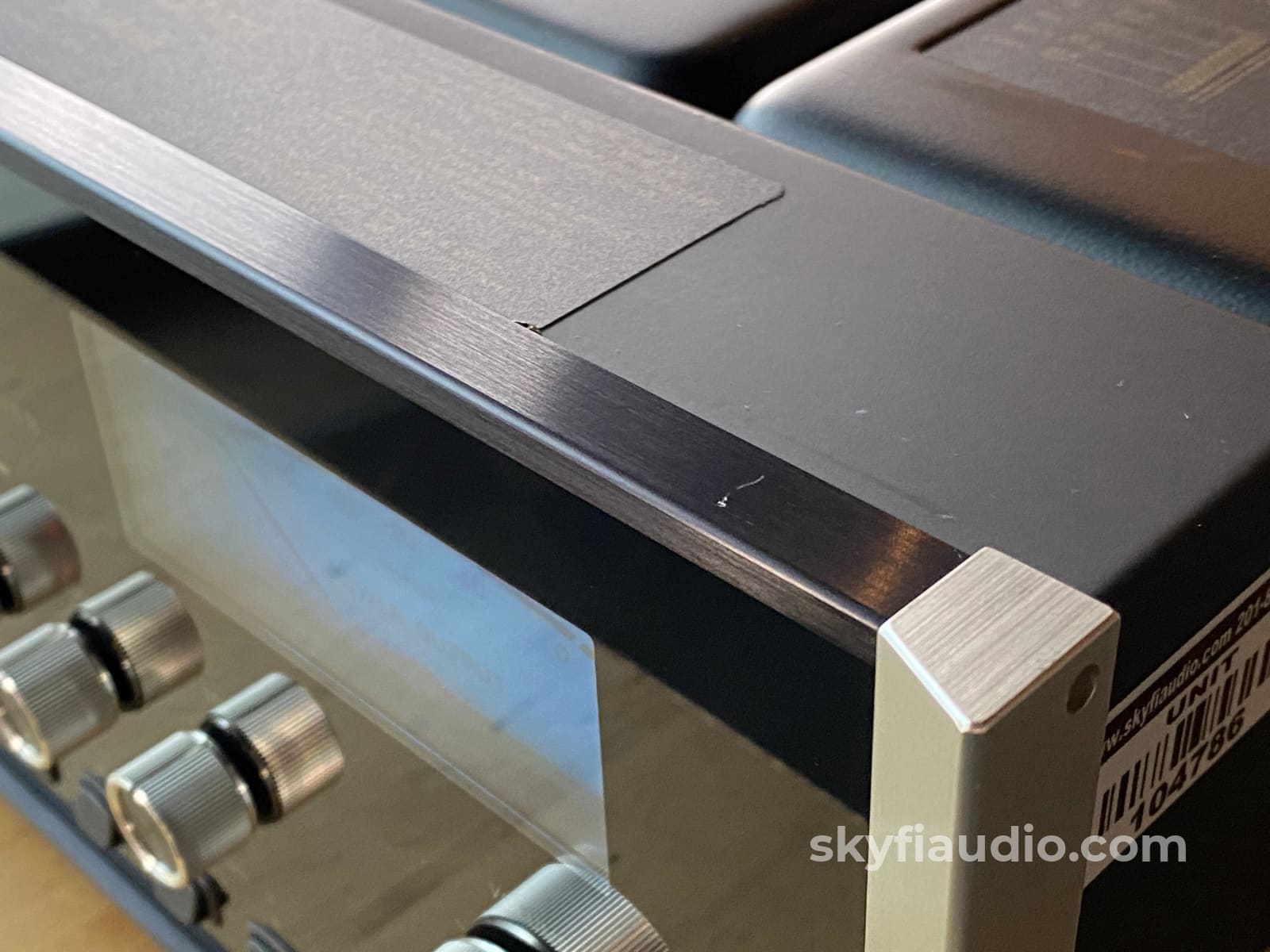













McIntosh MA6900 Integrated Amplifier - All Analog with Built-In Phono and EQ
Free Shipping on Most Electronics - Excludes Speakers and Items Requiring Freight - Contiguous U.S. Only
Pickup currently unavailable at SkyFi 479

McIntosh MA6900 Integrated Amplifier - All Analog with Built-In Phono and EQ
SkyFi 479
479 South Broad Street
Glen Rock NJ 07452
United States
General:
This is the last of the real McIntosh analog integrated amps, in gorgeous condition and fully tested.
Unlike modern integrated amplifiers, this unit has what we believe to be two distinct advantages.
For starters, instead of digital encoders it utilizes real potentiometers to manage the volume, balance, and EQ. This is the old school way and how McIntosh built their reputation.
Second, there is no DAC built into this unit. No superfluous, outdated converter, sitting there just making noise and taking up bandwidth from the power supply.
The EQ is also a really nice feature to get the most out of your vintage speakers. It even has a built in phono section for connecting basic turntables.
Tried and true McIntosh patented Power Guard helps to keep things from going wrong (and fast) to your speakers due to overdriving/clipping.
On this MA6900 the glass is impeccable, and the paintwork is devoid of any scratches or dents.
The original remote is included, and this will ship in a double McIntosh made official box guaranteeing safe transport.
Cosmetic Notes:
Light marks are present on the top surfaces of the top faceplate bezel. Light marks from unit stacking are visible on the tops of the autoformers. This unit was recently re-lamped. Please note that meters from this era are a slightly different color of blue than current McIntosh products so this integrated may not match aesthetically when mixed with modern McIntosh sources.
Standout McIntosh Features include:
• Power Output
The MA6900 consists of two separate power amplifier channels, each capable of 200 watts into 2, 4 or 8 ohm speakers with less than 0.005% distortion.
• Electronic Input Switching
Digital Logic integrated circuits drive Electromagnetic Switches on all six inputs and operating functions for reliable, noiseless, distortion free switching.
• Power Guard
Both channels include the patented McIntosh Power Guard circuit that prevents the amplifier from being overdriven into clipping, with its harsh distorted sound that can also damage your valuable loudspeakers.
• Sentry Monitor and Thermal Protection
McIntosh Sentry Monitor power output stage protection circuits ensure the MA6900 will have a long and trouble free operating life. Built-in Thermal Protection Circuits guard against overheating.
Patented Autoformers
McIntosh designed and manufactured Output Autoformers provide an ideal match between the amplifier output stages and speaker loads of 2, 4 and 8 ohms. The Autoformers also provide perfect DC protection for your valuable loudspeakers.
• Illuminated Power Meters
The Illuminated Power Output Meters on the MA6900 are peak responding, and indicate the power output of the amplifier.
Brand Background:
McIntosh Laboratory is an American manufacturer of handcrafted high-end audio equipment based in Binghamton, New York. The company was founded in 1949 by Frank McIntosh. The company designs and produces audio amplifiers, stereo tuners and other consumer electronics products.
Ownership:
Single Owner
Connections:
RCA inputs and outputs, XLR Inputs for CD, 5 way speaker binding posts, 12V triggers, IEC removable power cord
General Sound:
Neutral sound with little to no coloration
Cosmetic Condition:
8/10 = Very Good. Excellent front faceplate, one minor flaw on chassis side or top. See our detailed rating description here.
Working Condition:
Working perfectly and tested in our lab and listening room.
Included:
Unit, remote, and power cord.
Packing:
Original Manufacturers Packing
Recommended Cables
Kimber Kable - RCA Interconnects
Kimber Kable - Phono Interconnects
Kimber Kable - XLR Interconnects
Specs:
Power Output
Minimum sine wave continuous average power output per channel, all channels operating is:
200 watts into 2 ohm load
200 watts into 4 ohm load
200 watts into 8 ohm load
Rated Power Band
20Hz to 20,000Hz
Total Harmonic Distortion
Maximum Total Harmonic Distortion at any power level from 250 milliwatts to rated power output is: 0.005% for 2, 4 or 8 ohm loads
Dynamic Headroom
2.4dB
Frequency Response
+0, -0.5dB from 20Hz to 20,000Hz +0, -3dB from 10Hz to 100,000Hz
Sensitivity
Phono, 2.5mV for 2.5V rated output (0.5mV IHF) High Level, 250mV for 2.5V rated output (50mV IHF) Power Amplifier Input, 2.5V for rated output
Signal To Noise Ratio (A Weighted)
90dB (84dB IHF) below 10mV input, Phono Input 100dB (90dB IHF) below rated output, High Level 110dB below rated output,
Power Amplifier
Intermodulation Distortion
Maximum Intermodulation Distortion if instantaneous peak output per channel does not exceed twice the rated output, for any combination of frequencies from 20Hz to 20,000Hz, with all channels operating is:
0.005% for 2, 4 or 8 ohm loads
Input Impedance
Phono, 47K ohms, 65pF High Level, 22K ohms
Maximum Input Signal
Phono, 90mV High Level, 8V
Preamplifier Maximum Voltage Output
Phono, 8V at tape output
High Level, 8V at tape output Main Out, 8V at preamp output
Voltage Gain
High Level to Tape: 0dB High Level to Main: 20dB
Wide Band Damping Factor
Greater than 40
Power Requirements
100 Volts, 50/60Hz at 5.2 Amps 110 Volts, 50/60Hz at 4.8 Amps 120 Volts, 50/60Hz at 4.4 Amps 220 Volts, 50/60Hz at 2.45 Amps 230 Volts, 50/60Hz at 2.35 Amps 240 Volts, 50/60Hz at 2.25 Amps
Note: Refer to the rear panel of the MA6900 for the correct voltage.
Dimensions:
Front Panel: 17-1/2 inches (44.45cm) wide, 7-1/8 inches (18.10cm) high. Depth behind front mounting panel is 16- 1/2 inches (41.91cm). Clearance required in front of the Front Panel is 1 inch (2.54cm) for knobs.
Weight:
75 lbs.
Link to Manual:
Click Here
The SkyFi Testing Process for Integrated Amplifiers:
We start with a visual inspection of all internal components to make sure that there are no signs of heat stress or damage. Capacitors are checked for telltale signs of predictive failure including bulging, shrunken wrappers, or physical leakage. We also inspect the PCBs for discoloration from resistors or transistors that may have been running hot. On vintage units we often spot check select capacitors for value and ESR.
If the device has the ability to decouple the preamplifier from the power amplifier, we remove the jumpers and independently test each section. If the device cannot be decoupled, we assess the electronic condition of the piece by analyzing the speaker level output only.
We start by connecting the “preout” jacks of the integrated to a Sencore PA81 Power Analyzer which simulates real world loading conditions and gives us an oscilloscope interface. The first order of business is checking that the volume control works smoothly throughout its entire range with acceptable channel balance. This is accomplished by feeding a 1KHz sine wave into one of the preamp’s line level inputs while monitoring the preamp’s output on an oscilloscope. We then switch to a 1KHz square wave to test the tone controls, loudness function, and filters where applicable. During this step we are watching for equal alteration of the test signal by both channels. This also helps us identify dirty controls that will need treatment. Once the basic line stage functions are verified, we test each input individually. This is especially important for devices that use relays to select their sources. If the preamp section is equipped with a phono stage we test that as well. We use an inverse RIAA filter which allows us to feed a reference test signal into the phono input with the proper RIAA equalization and level. A square wave or sine sweep is used to verify that the device’s phono stage is faithfully reproducing the RIAA curve.
Next, we test the power amplifier section by connecting the integrated’s speaker outputs to a Sencore PA81 Power Analyzer which acts as a dummy load, DC offset monitor, and oscilloscope interface. We start with a low level 1KHz test signal at the “main in” jacks and slowly increase its amplitude while monitoring the output on an oscilloscope for signs of noise, clipping, distortion, or improper channel balance. We continue increasing the signal level until the amplifier reaches clipping. At this point we take an output power measurement and compare it to the spec sheet of the amplifier to verify proper performance.We finish off the bench evaluation with a 1KHz square wave check and a 20Hz to 20KHz sine sweep to assess the amplifier’s frequency response characteristics. This battery of tests will usually reveal if the amplifier has any issues that need further attention.
If the preamp and power amp both pass these tests, we reconnect the sections and verify that the preamp section can drive the power amp to rated power with a 1KHz tone on one of the line level inputs.
Before the device leaves the bench, we perform a listening test with actual music using a variety of preferred test tracks. Our benches are outfitted with familiar monitor speakers which help us identify inconsistencies that will not always show up on our test gear. The main things that we are listening for are hum or noise with no signal present, proper center image, clicks, pops, or any other obvious undesirable audio characteristics.
If the unit passes all of these tests it is moved to our long term testing rig where we simulate real word operating conditions for 6-8 hours. This allows us to monitor the unit for signs of thermal runaway or intermittent issues that only crop up when the unit has fully come up to temperature.
Choose options
